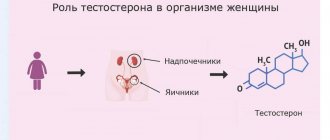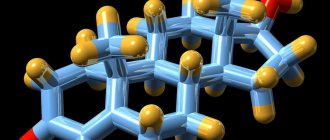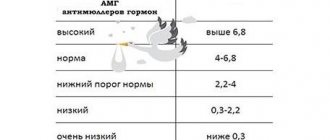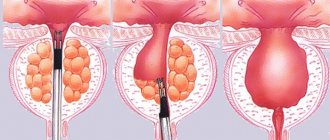Testosterone hormone in men
This hormone belongs to the group of androgens (steroid) , produced by Leydig cells in the testes and adrenal cortex. Testosterone in men
can be connected and active. Androgen is bound by proteins that perform a transport function, delivering the active substance to target organs. Active testosterone moves throughout the body and penetrates cells unhindered. The percentage of bound to active testosterone is 98% to 2%, respectively.
The main functions of testosterone in men include:
- regulation of the reproductive system, potency;
- puberty;
- development of secondary sexual characteristics;
- building muscle mass;
- regulation of metabolism;
- psychophysiological characteristics of behavior;
- control over sperm maturation.
The maximum level of the hormone is observed during puberty and in adult men. With age, testosterone concentrations decrease. The hormone mainly circulates in the body associated with albumins (54%), globulins (44%). It has an effect on tissue only in its free form. Total testosterone is determined in the blood serum using chemiluminescent immunoassay. If abnormalities are found, the serum bound globulin (SHBG) is checked.
The amount of testosterone depends on several factors:
- Young adulthood - the norm is 300-1000 ng/l;
- After 60 years - 50% lower;
- Seasons: androgen levels increase in autumn;
- Time of day: in the evening the amount of the hormone decreases by 13%, in the morning it increases.
Testosterone begins to work in males from the age of 13. Its task is to stimulate hair growth, the development of the musculoskeletal system and genital organs, influence spermatogenesis, the ability to ejaculate, the appearance of libido and loss of voice. In adolescents, body hair begins to actively grow, the voice “breaks” and bone tissue matures. In adult men, testosterone “guides” sexual function and arousal.
The main functions of testosterone in the male body
Increased testosterone in men
The amount of testosterone is controlled by the pituitary gland (an endocrine gland in the brain). When levels are low, the pituitary gland secretes hormonal substances that stimulate the testes to produce testosterone. The cause of excess of this hormone is active physical activity, endocrine tumors, Itsenko-Cushing syndrome, and genetic disorders.
Consequences of increased testosterone:
- Infertility;
- Strong growth of hair on the body;
- Alopecia on the head;
- Acne on the face;
- Apnea;
- Blood clot formation;
- Malignant neoplasm of the prostate;
- Instability of psycho-emotional state.
Low testosterone in men
The reason for the decrease in the amount of testosterone is dysfunction of the pituitary gland, hypothalamus, testicles, adrenal glands, Alzheimer's disease, obesity, steroid use, alcohol abuse and smoking. Lack of physical activity, unhealthy diet, stress, emotional tension in family relationships and conflicts also affect this. A natural decrease in sex hormone occurs after sex. The main manifestation of androgen deficiency is the formation of a female body type.
A man’s inability to conceive a child may indicate a low level of the hormone, therefore, if infertility is suspected, a testosterone test in men is required; the price can be obtained from a clinic consultant. To determine your testosterone level, you need to properly prepare: blood is donated in the morning on an empty stomach, 10 hours before you need to refuse food and water, and avoid psycho-emotional and physical overload.
Consequences of low testosterone in men
Interpreting testosterone blood test results
The principle of deciphering analysis results almost always consists of comparing the patient’s analysis data with reference values, that is, the norm. It is worth keeping in mind that units of measurement vary between clinics. So testosterone levels can be expressed in nmol/l, ng/ml, pg/ml.
Typically, analysis results forms indicate standard values in the units of measurement used by the clinic, which allows the patient to make a preliminary conclusion about the results of the analysis. However, it is worth understanding that deviations from the norm are not always a consequence of pathological processes. There are also physiological fluctuations. For example, the maximum concentration of androgens (including testosterone) is observed in the early morning, after which the level begins to decline, reaching a minimum in the evening hours. There is also a circadian rhythm of testosterone synthesis: in the spring the level of this hormone is maximum and in winter it is minimum. Short-term jumps in concentration can be observed due to stress, depression, after a heavy meal, or serious physical activity (which leads to a short-term increase in testosterone levels in the blood). Such fluctuations are normal.
Testosterone levels in women and men
Normal serum testosterone levels vary across different age groups:
- boys/men under 18 years of age: from 0.2 nmol/l to 37.67 nmol/l;
- men from 18 to 50 years old: from 5.76 nmol/l to 30.43 nmol/l;
- men over 50 years of age: from 5.41–19.54 nmol/l;
- girls/women under 18 years of age: from 0 to 4.73 nmol/l;
- women over 18 years of age: 0.31–3.78 nmol/l;
- pregnant women: 3–4 times increase in hormone levels;
- postmenopausal women: 0.42–4.51 nmol/l.
Hormone levels are increased
Sometimes high testosterone does not indicate the presence of serious pathologies. In women, SHBG increases when taking oral contraceptives and during pregnancy. Both sexes experience high SHBG when taking medications for epilepsy and hyperthyroidism. Most often, elevated testosterone levels indicate health problems.
In women, high testosterone may indicate genetic disorders, hyperfunction of the adrenal cortex, tumors and other pathologies of the ovaries, uterine fibroids, endometriosis, and disorders of the pituitary gland.
In men, elevated testosterone indicates liver disease, prostate cancer, adrenal hyperplasia, diseases in which the body loses sensitivity to androgens, Reifenstein syndrome (male pseudohermaphroditism), pituitary tumors. Testosterone also increases when taking steroids.
Testosterone hormone in women
Functions of testosterone in a woman's body
Testosterone analysis - what is it in women?
The male sex hormone testosterone is produced not only in the body of men, as most believe, but also in the female body. Excessive amounts of it can cause many disorders. Its main role in the female body is to control the ratio of fat and muscle tissue, the production of estrogen, and the development of the follicular apparatus. The synthesis of the hormone in the body of women occurs in the ovaries and adrenal glands.
Testosterone test in women - when to take it?
Testing to determine the level of testosterone in the blood of women is carried out for various menstrual cycle disorders, recurrent miscarriage, gynecological pathology, as well as pathology of the mammary glands and hirsutism.
How to give testosterone to a woman?
A blood test for testosterone requires special preparation:
- It is not recommended to donate blood for acute diseases of viral or bacterial etiology;
- collection is carried out 14 days after recovery;
- inform the doctor about taking any medications (hormonal agents, cytostatics, glucocorticoids);
- material collection occurs in the morning;
- the day before it is important not to eat for 8-14 hours;
- exclude any physical activity, emotional distress and stress;
- do not smoke for at least an hour before the test.
Complexes with this research
Fitness monitoring Examination to select physical activity and monitor the body's condition 6,780 ₽ Composition
Check-up No. 1 for children and adolescents Annual preventive examination program 10,950 ₽ Composition
Advanced anti-aging diagnostics in postmenopause Advanced monitoring of age-related changes during postmenopause RUB 29,230 Composition
IN OTHER COMPLEXES
- Anti-aging diagnostics in postmenopause RUB 12,630
- Adrenogenital complex RUB 2,560
- Men's check-up No. 1 RUB 18,570
- Preventive check-up 6,300 ₽
- Fitness control of sports nutrition RUB 5,140
How does testosterone deficiency manifest?
Testosterone deficiency in boys, which occurs before puberty, inhibits the formation and growth of the penis and testicles, and promotes enlargement of the mammary glands. In adolescents, there is insufficient facial and body hair, and later wet dreams and erections appear.
The main symptoms of testosterone deficiency in men:
- low sex drive;
- weak sexual activity;
- rare morning erections;
- insufficient erection during sexual intercourse.
Less specific signs:
- mood swings, depression;
- increased fatigue and irritability;
- insomnia;
- general weakness;
- male infertility;
- enlargement of the mammary glands;
- decrease in muscle mass;
- fat deposition around the internal organs and on the anterior abdominal wall (visceral and abdominal obesity);
- fractures due to minor trauma due to decreased bone density (osteoporosis);
- hot flashes;
- deterioration of memory, ability to concentrate.
Rules for preparing for sperm culture and spermogram
For culture, sperm can be collected at home. It is first necessary to carry out thorough hygiene of the external genitalia. Sperm is collected only after urination and in the morning. The material is collected in a container, which must be tightly closed immediately after collection. It is important that at least 5 days have passed since the last sexual intercourse. You cannot visit baths and saunas for 7 days.
For a spermogram, sperm obtained through masturbation is donated. Moreover, it is necessary to submit the material in the laboratory, since some indicators must be assessed in the first 30 minutes. Before the study, it is important to limit intimacy for at least 2, but no more than 5 days. For a week you need to eliminate going to the sauna and bathhouse and even heating the car seat, and for a week you need to give up smoking and alcohol.
How to prepare for a urethral smear (for infection, flora, PCR)
To examine a smear, material is taken directly from the urethra. To do this, a special instrument is carefully inserted into it a few centimeters, after which a couple of rotational movements are made and the taken material is applied to a glass slide. In the future, it can be used for various studies, including the study of flora, PCR and ELISA.
Preparation for a urethral smear in men is as follows:
- A week before the procedure, stop taking antibiotics.
- Avoid intimacy for 1-2 days before the procedure.
- Take a shower the night before.
- Give up alcohol in 1-2 days.
- In the morning before taking a smear, do not urinate for at least 2-3 hours, since urine washes away the flora from the mucous membrane.
- Do not use antiseptics for toileting the genitals during the day before the test.
Since the taken material can be used for various studies, you can prepare for them according to the listed rules. They will act to prepare men for a smear for flora, for PCR from the urethra.
Make an appointment with a urologist and do the necessary tests
To find out what tests are needed in your case, make an appointment with a qualified urologist.
The State Urology Center conducts all the necessary urological examinations, which you can undergo under the compulsory medical insurance policy. All tests can be done on days convenient for you and in the shortest possible time, which will allow you to quickly obtain the results the urologist needs to make a diagnosis. January 20, 2021
Hakobyan Gagik Nersesovich - urologist, oncologist, MD, doctor of the highest category, professor of the Department of Urology of the Federal State Autonomous Educational Institution of Higher Education First Moscow State Medical University named after. THEM. Sechenov
All publications...
Indications for prescribing the study
For boys, a blood test for testosterone is prescribed when:
- delayed puberty: lack of muscle mass, high-pitched voice, lack of body hair, small penis and testicles;
- premature maturation: the appearance before the age of 10 of a low voice, coarse hair on the body and face, acne, pronounced muscular structure.
For men and women, the analysis is indicated for low libido, infertility, and tumors of the gonads. Men need a test for reduced potency, chronic prostatitis, or suspected premature onset of male menopause.
In women, the study is most often performed for symptoms of increased androgen levels (hyperandrogenism):
- hair growth on the face and limbs, along the midline of the abdomen;
- lack of ovulation;
- dysfunctional uterine bleeding;
- insufficient development of the uterus and mammary glands;
- clitoral enlargement;
- polycystic ovary syndrome;
- miscarriage.









